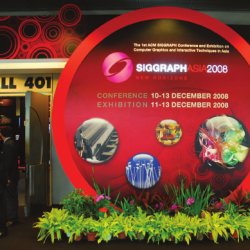
Each year, computing enthusiasts from around the world are drawn to SIGGRAPH, the annual ACM conference that has built a reputation as a must-attend event for the latest breakthroughs in computer graphics and related technologies. In a move that conference organizers say was motivated by a desire to foster a more global focus at the event and to recognize Asia’s growing importance in graphics and digital media, SIGGRAPH Asia took place in Singapore, marking the first time that SIGGRAPH has appeared outside North America.
The inaugural SIGGRAPH Asia conference was held December 1013, 2008 at the Suntec Singapore International Convention & Exhibition Centre, with programs mirroring the format of previous SIGGRAPH events. "It was a real SIGGRAPH-level conference in quality and look-and-feel," says G. Scott Owen, president of ACM SIGGRAPH and professor emeritus at Georgia State University. "I was very pleased with SIGGRAPH Asia, and everyone I talked to was also pleased."
The conference, which drew 3,389 attendees, served as a showcase for digital artwork and interactive platforms. It also offered workshops, technical presentations, and an exhibition that highlighted the newest products and services from 81 companies.
Yong Tsui Lee, conference chair of SIGGRAPH Asia 2008 and a professor at Nanyang Technological University, says it wasn’t difficult to create interest in the show among those who were already familiar with SIGGRAPH. "Its reputation as the world’s largest and highest-quality event in computer graphics and interactive techniques helped open doors," he says. "Its name helped draw a good audience." Still, Lee says, it was difficult to built interest in the show among people who didn’t know SIGGRAPH well. "So, a lot of hard work was needed."
By most accounts, the hard work paid off. SIGGRAPH Asia featured notable speakers such as Cornell University’s Don Greenberg, Pixar’s Rob Cook, and Lucasfilm Animation Singapore’s Lee Stringer and Matt Aldrich. At the Computer Animation Festival, attendees were able to view 68 films selected for screening from 685 submissions, and the Emerging Technologies program featured projects designed to push the boundaries of computer graphics. In all, SIGGRAPH Asia’s Technical Papers program received 320 submissions, from which 59 were selected for publication, making for an acceptance rate slightly lower than SIGGRAPH’s 10-year average.
Every SIG conference depends on the help of many volunteers, and SIGGRAPH Asia garnered the support of 135 volunteers from 17 countries. In terms of the number of attendees, Lee says it would have been nice to have more, but "looking at how some of our sessions filled up, I suppose 3,400 is about what we could handle comfortably this time."
SIGGRAPH Asia 2009 is slated for Japan, with preparations for the show already under way. "My committee and I are discussing ways to continue the SIGGRAPH Asia 2008 program, but we are considering some changes," says Masa Inakage, conference chair of SIGGRAPH Asia 2009 and dean of Keio University’s Graduate School of Media Design. In particular, Inakage says he plans to expand the show’s Emerging Technologies program and tailor some course content to reflect Japanese and other Asian cultures. "We are hoping to attract a much larger number of attendees," he says, "locally and internationally."



Join the Discussion (0)
Become a Member or Sign In to Post a Comment